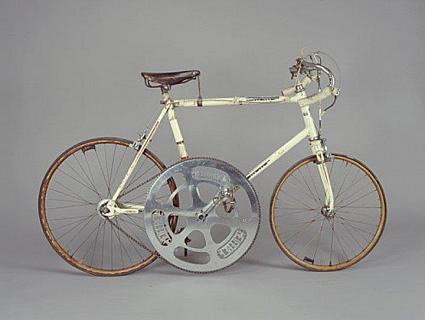
In 1962, José Meiffret used this odd-looking bike to ride down the German Autobahn at an incredible, record-breaking 127 miles per hour. That gigantic gear had 130 teeth. The bike had wooden rims to keep it from overheating. It weighed 45 pounds. And it went fast. As. Hell.
Meiffert practiced a type of cycling called “motor-paced racing” in which, rather than riding with a group of other cyclists, the racer rides behind a motorcycle or a car equipped with a wind-screen. American Cyclist explained it like this, in a 1965 article on Meiffret’s exploits:
Racing behind motorist is quite different from racing in a group. Behind motors, the speed is higher, the pedaling faster, the concentration greater. It is like a continuous sprint. A motor-paced rider must have suppleness rather than strength. And he must have flair.
Also, a high tolerance for risk. Riding at these speeds — 70, 80, 90 miles per hour — isn’t exactly safe. And Meiffert’s attempt to ride faster than 200 kmh — 124 mph — easily could have killed him. American Cyclist:
Getting under way with a gear of 225 inches was something else again. A motorcycle came alongside and started pushing him. At 20 miles an hour, Meiffret was struggling to gain control. His legs were barely moving. At 40 miles, he was beginning to hit his stride. At 50 miles, the Mercedes with its curious rear end was just behind. With a wave of his hand, Meiffret dismissed his motorcycle and connected neatly with the windscreen of the Mercedes. His timing was perfect. He had overcome his first great hazard.

American Cyclist
The screen had a roller, but if he should touch it at 100 miles an hour, he would be clipped. On the other hand, if he should fall behind as little as 18 inches, the turbulence would make mincemeat of him. If the car should jerk or lurch or hit a bump, he would be in immediate mortal danger. An engineer had warned him that at these speeds, the centrifugal force might cause his flimsy wheels to collapse.
Meiffert didn’t flinch or falter or make a mistake, though. He kept telling his driver to go, go. Fast. Faster. Flying! American Cyclist:
He was the flying Frenchman, the superman of the bicycle, the magician of the pedals, the eagle of the road, the poet of motion. He knew that he must live in the rarefied atmosphere for eighteen seconds. When he passed the second flag, the chronometers registered 17.580 seconds, equivalent to 127.342 miles an hour.
Mad respect. We’re pretty sure we’d hop on that bike, immediately get our pant leg hopelessly tangled in the monster gear, and fall over.




